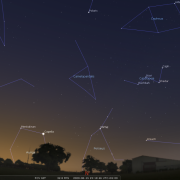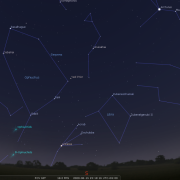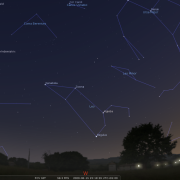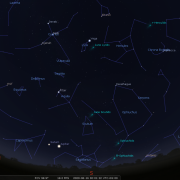Greetings to you all for your monthly edition of the Locked-Down WDAS newsletter. Continuing from last month, ufortunately all events are cancelled due to the current Corona Virus restrictions, up to and including Whitby Regatta. The night sky, however, still as bright as ever: enjoy! (Disclaimer: Night Sky should be enjoyed safely in a back-garden with up to six neighbours, suitably socially distanced. (^_^))
Welcome to the WDAS monthly newsletter for June 2020: a digest of the month's latest contributions to our website. Below you'll find Society News: including some superb photos from our Members, photos from the Dark Sky Evening at Fyling Hall School, and naturally your Sky Notes for March with details of two comets!
Society News
They say June's Full Moon got its name as it's the month when wild strawberries begin to ripen. ('Evidently not named by a Canary Islander!' --Andi) Be that as it may, Mark has been out in force to take some photos for you pleasure and delight. So ('Odd-one-out' round) which of these Moons is not a Strawberry Moon?
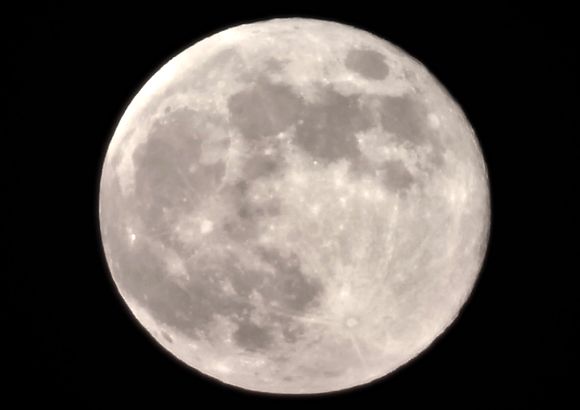
07-May-2020: Full Moon rising over East Side of Whitby.
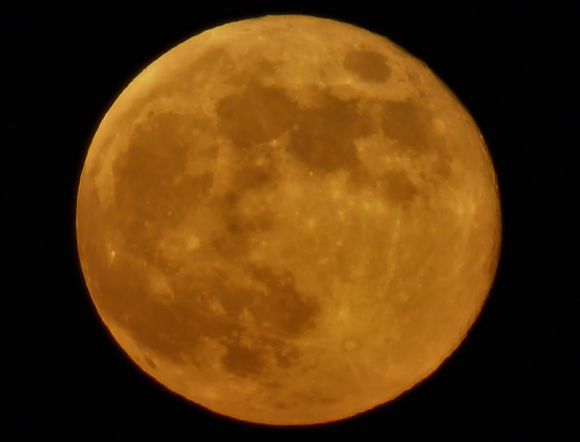
07-May-2020: "Not-so-strawberry" Moon.
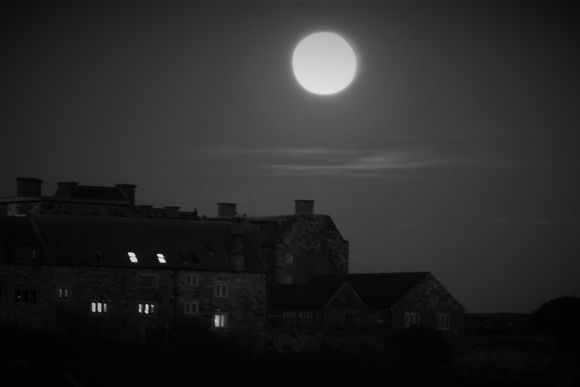
07-May-2020: Full Moon rising over East Side of Whitby.

27-May-2020: Crescent Moon.
Mercury really is particularly small and faint in the sky; particularly as it never appears in a dark sky. Try to spot Mercury in these pictures.

22-May-2020 at 21:30h: Venus and Mercury just above roof.
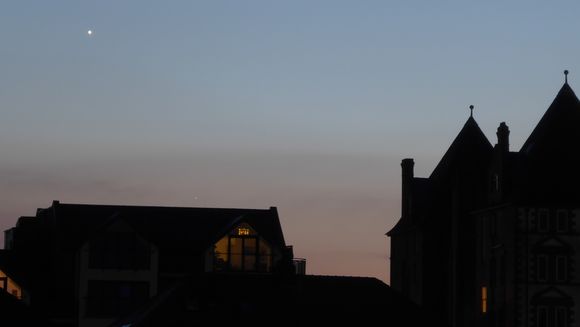
22-May-2020 at 21:30h: Venus with Mercury below, West Cliff.

22-May-2020 at 21:30h: Venus with Mercury to the left.

22-May-2020 at 21:30h: Venus and Mercury.
Sky Notes
In this month's Sky Notes:
- Planetary Skylights
- Lunar Occultation of Venus
- Meteors
- Comet C/2020 F8 SWAN
- Summer Solstice 2020
- Noctilucent Clouds 2020
- June 2020 Sky Charts
Planetary Skylights
Evening Planets
 With the rapid departure of Venus from the evening sky at the end of last month, Mercury will be readily visible for the first week of June very low in the WNW twilight sky from around 40 minutes after sunset (22:20h). Look for what appears as a solitary ‘star’ not far above the horizon. On June 4thMercury reaches greatest east elongation from the Sun, approximately 24 degrees, so at least it will not be swamped in very bright solar glare. Use binoculars to help pick Mercury out of the twilight before trying with just the naked eye.
With the rapid departure of Venus from the evening sky at the end of last month, Mercury will be readily visible for the first week of June very low in the WNW twilight sky from around 40 minutes after sunset (22:20h). Look for what appears as a solitary ‘star’ not far above the horizon. On June 4thMercury reaches greatest east elongation from the Sun, approximately 24 degrees, so at least it will not be swamped in very bright solar glare. Use binoculars to help pick Mercury out of the twilight before trying with just the naked eye.

02-Jun-2020 at 22:15h (WNW): Mercury in the late evening twilight.
The dawn sky, which in reality means the middle of the night or 03:00h at this time of year, has three planets vying for attention: Jupiter, Saturn and Mars.


Jupiter and Saturn will actually be visible from 23:00h towards the end of the month, but will be better placed for observations low in the SSE post midnight.
The two largest planets are fairly close together in the sky with Jupiter by far the most conspicuous of the pair, a fantastic object to view with a telescope, or even binoculars. Look for the banding across the disk and the attendant Galilean moons, which throw up a different configuration each night. The ‘great red spot’ can also be viewed when orientated towards earth, its size and colour being of particular interest to astronomers after many years of ‘shrinkage’. The following dates are when the GRT is in transit on the disk; 5th, 7th, 12th 17th, 19th, 22nd, 24th, and 29th all between 1-03:00h.
Interesting shadow transits of Galilean moons occur for Europa on the 1st (before 02:00h) and the 8th (after 01:37h); Io on the 16th (before 03:00h) and 23rd (after 02:48h); and Ganymede on the 26th (before 02:50h)

01-Jun-2020 at 03:15h (SE): Saturn, Jupiter and Mars

09-Jun-2020 at 03:15h (S): Saturn, Jupiter and The Moon
Saturn resides to the left of Jupiter and although not as bright is still conspicuous. Unless you have really ‘serious’ binoculars, a telescope is required to view the wonderful ring system, which is currently well orientated with respect to Earth, although very modest instruments will suffice. With Saturn and Jupiter both low in the sky where the air is more turbulent, patience at the eyepiece will pay dividends waiting for those steady seeing moments. Look for Saturn’s largest moon, Titan, which is visible as an obvious speck of light close by. The waning moon passes below Jupiter and Saturn on the 9th.

13-Jun-2020 at 03:15h (SE): Mars and The Moon
The distinct orange hue of Mars continues to edge away from Jupiter and Saturn, residing further round to the ESE amongst the stars of Aquarius at the start of the month and Pisces at the end. To the naked eye the red planet appears a rather conspicuous magnitude -0.5 object, still a long way to go before it dominates the evening sky. Telescopically however, Mars appears disappointingly small with surface detail difficult to detect, not helped by the low altitude. Matters will improve, but not for a few months yet. The moon passes Mars on the 13th.
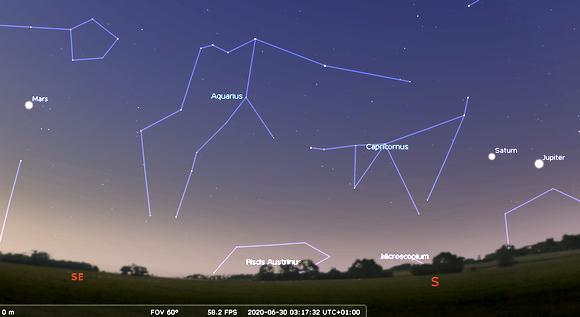
30-Jun-2020 at 03:15h (SSE): Mars, Saturn and Jupiter.
Lunar Occultation of Venus
Having departed from the evening sky after a prolonged and ‘blazing’ apparition, Venus is not quite done yet vying for our attention, even when not readily visible to the naked eye at all!
On the morning of the 19th a very slim waning crescent moon joins Venus in the sky passing in front of the planet in what is termed an occultation. ‘Morning’ means broad daylight, around 08:40h, which poses a number of problems; finding the Moon (and hence Venus) and observing the event safely with the Sun in relative close proximity.
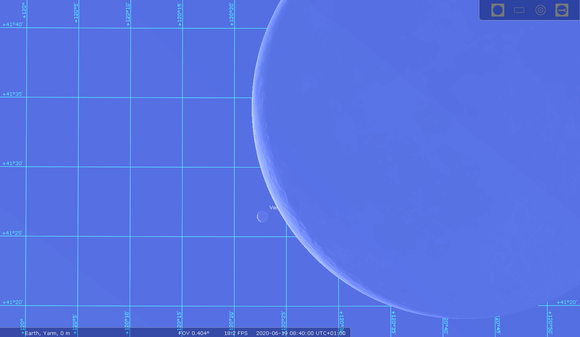
19-Jun-2020 at 08:40h: Crescent Venus and The Moon.
Unless you know what you are doing this will be challenging, so be ultra aware of where you are looking. And where are you looking? The Moon will be just 25 degrees to the upper right of the Sun at 08:40h. To quantify this, a spread hand at arm’s length is around 18 to 20 degrees in extent, so do not stray any closer to the sun than an outstretched hand. If you have a GOTO computerised telescope locating the moon will be relatively simple, but check where it is pointing first. Failing a GOTO system, a compass and tape measure and good estimation will suffice. If you have a compass and set it to north (0 degrees), then the moon and Venus will be at 120 degrees at 08:37h on the 19th approximately 31degrees above the horizon. This altitude is equivalent to a tape measure height at arm’s length of 47cm from the horizon.
Note roughly where that spot is, and ideally hiding the sun behind the edge/corner of a house (or similar), use binoculars or finder scope to initially scan for the Moon. Once acquired you should see a very slender crescent moon, and also a small crescent Venus close by the lit portion. The moon begins to occult Venus at 08:42h, re-emerging from the dark limb around 09:48h.

19-Jun-2020 at 09:50h: Venus re-emerging from behind the lunar limb.
It will be fascinating to see the two bodies that are (or can be) closest to Earth meeting up in the sky and a great opportunity to experiment taking some images through the eyepiece. Just be careful, no eye injuries please!

29-Jun-2020 at 09:50h (ENE): Venus.
Meteors

June is a quiet month for meteors with just a couple of minor showers; the Ophiuchids and the lesser known June Lyrids. The former has two maxima, June 9th and June 20th, with peak rates barely reaching sporadic levels (around 5 per hour). The same can be said about the June Lyrids which peak on the 15/16th.
You will be fortunate to spot any meteors belonging to these showers before midnight – which realistically leaves a couple of hours post midnight. Ophiuchus will occupy the area of sky low to the south, whilst Lyra is located high to south during the early morning hours. Moonlight will only interfere with observations before the 13th.
Comet C/2020 F8 SWAN
After the untimely disintegration of comet Atlas, Comet f8 Swan almost made an actual observational breakthrough. It certainly created some, quite frankly, much over hyped, sensational headlines in the press and media, out of all proportion with the reality ( a worrying trend) And the reality was that from locations further south in the world, Comet Swan appeared as a pretty good astro-imaging object and viable naked eye comet. For northern hemisphere observers, particularly those further North, Comet Swan has been rather challenging to view satisfactory however.

28-Apr-2020 at 20:20h: Comet C/2020 F8 Swan. (Image Credit: Damian Peach/Chilescope team.)
The closest approach of Comet Swan to Earth occurred on May 13th at a distance 0.56 AU or 85 million Km. At its brightest Comet Swan reached magnitude +5.4 and from the UK mag +6 around May 20,21,22nd. Perihelion passage (i.e. closest approach to the Sun), at a distance of 64 million kilometres (0.43AU, or 40 million miles) from the Sun, occurs on 27 May.
As of writing during the final week in May, Comet Swan was circumpolar skirting above the north horizon. It has faded to mag 6.5 but because of its low altitude and limited period of ‘dark sky’ availability it has been a challenge to track down in the haze. The best ‘time window’ of around 02:30h is also rather inconvenient. Several society members have though succeeded in spotting the comet through binoculars, although any images taken are not very satisfactory. Comet Swan should still be visible in early June in the constellation of Auriga, passing below its chief star Capella on the 4th.
Summer Solstice 2020

Summer Solstice 2020: Enjoy the Summer folks! (Image Credit: Andape)
The summer solstice in the northern hemisphere falls on June 20th when the Sun reaches its greatest altitude in the sky on the ecliptic; the path it takes across the sky during a year.
It is often wrongly assumed that Earth lies closer to the Sun at this time of year; in fact the opposite is true. Earth is actually furthest from the Sun on July 4th at almost 95 million miles, nearly 3 million miles more than when at its closest approach in early January. It is the inclination of the northern hemisphere towards the sun which causes days to feel warmer due to the higher concentration of sunlight per unit area. Think of this as being like a spot light directed onto to the palm of your hand, your palm feels hotter under direct radiation, whereas when the light is tilted, the angle reduces the heat intensity. The actual intensity of solar radiation in June is equivalent to approximately 1.2KW of heat for each square metre on the surface!
Although known as the longest day, earliest sunrise and latest sunset times do not occur on the summer solstice date. Earliest sunrise falls around June 16th (from Whitby:- 04:25h) whilst latest sunset occurs on June 25th (Whitby:-21:42h). It is the duration of useable daylight which reaches a maximum on the 21st, at just over 17 hours, with a meagre 4 hours of semi darkness.
Noctilucent Cloud
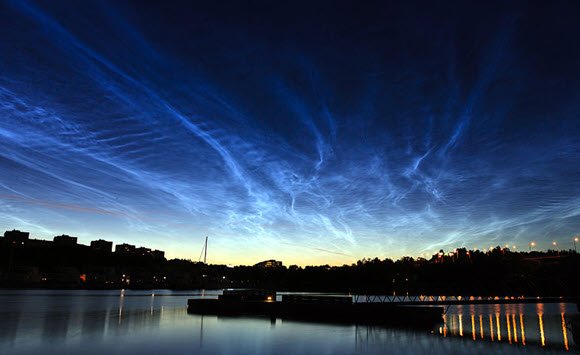
12-Jul-2014 at 01:11h CET: Noctillucent Clouds over Stockholm, Sweden. (Image Credit: Kevin Cho)
With bright twilight persisting well into the night, throughout June and into the July, watch out for the beautiful type of cloud formation seen only at this time of year known as Noctilucent cloud. These delicate formations appear above the northern horizon, long after sunset, often around midnight. Shining quite brightly, Noctilucent cloud is filamentary in structure, having a characteristic silvery-blue colour. It forms almost exclusively between latitudes 50 and 60 degrees north, high in the upper atmosphere: 50 miles up- five times higher than normal clouds.
It is thought that this type of cloud forms when water vapour condenses at the low temperatures that prevail at such altitudes onto particles suspended in the air. More frequent sightings of Noctilucent cloud over the last half century may indicate that these particles could be a result of industrial pollution, perhaps from increased air traffic. Do keep a watch!
|
Looking North
Mid-June - 23:15h |
Looking South |
|
Looking East
Mid-June - 23:15h |
Looking West
Mid-June - 23:15h |
|
Northern Aspect
Mid-June - 02:00h |
Southern Aspect
Mid-June - 02:00h |
Additional Image Credits:
- Planets and Comets where not otherwise mentioned: NASA
- Sky Charts: Stellarium Software



